R.J. Stowell's Blog: rjsomeone, page 2
December 15, 2021
50 Years Ago - Joni and James
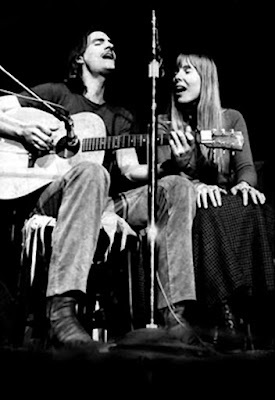 Joni Mitchell’s relationship with James Taylor, while brief (six months if you listen to Joni; a year according to James), inspired a myriad of songs on Joni’s first real venture into jazz, For the Roses. With Joni in the studio (A&M), by December 1971, Taylor was already immersed in his relationship with Carly Simon. While we tend to look more fondly and intently on Joni’s affair with Graham Nash, the “Our House” era, it was James with whom Joni felt she’d found her pair-bond. With the relationship’s demise, Joni put the Lookout Mountain house in Laurel Canyon up for sale and fled to British Columbia. For recovering addicts, moving to another locale to escape the confines of substance abuse is called a "geographic cure," and that's what James Taylor, battling an addiction to heroin, was looking for when he moved to London in 1968. His debut LP on Apple Records, while critically acclaimed, went unnoticed and James moved back to L.A. a year later, sleeping on Peter Asher’s couch (he was only 21 years old). Upon her return to L.A. from Crete, Joni started seeing James and in that time, the couple accentuated each other’s work, their lyrics and vocals intertwining as Taylor played on Joni's "California," "All I Want" and "A Case of You," and Mitchell provided vocal backup for Mud Slide Slim and the Blue Horizon.For the Roses' most telling song is “Cold Blue Steel and Sweet Fire,” Joni’s lament on James’ addiction. Some speculate that “A Case of You” from Blue was also written about James (or Leonard Cohen) alongside “Blue” and “All I Want.” (Taylor plays guitar on “California,” “All I Want” and interestingly “A Case of You.”) The James tracks on For the Roses include “See You Sometime,” the title song, and “Woman of Heart and Mind.” The next year, Mitchell would pen “Just Like This Train” for Court and Spark, a painstaking portrayal of their relationship. James in turn would write “You Can Close Your Eyes” for Mud Slide Slim. The couple would record a version that’s been released on The Reprise Years Vol. 2, from the Joni Michell Archives.https://youtu.be/7VrkaMlPGw0
Joni Mitchell’s relationship with James Taylor, while brief (six months if you listen to Joni; a year according to James), inspired a myriad of songs on Joni’s first real venture into jazz, For the Roses. With Joni in the studio (A&M), by December 1971, Taylor was already immersed in his relationship with Carly Simon. While we tend to look more fondly and intently on Joni’s affair with Graham Nash, the “Our House” era, it was James with whom Joni felt she’d found her pair-bond. With the relationship’s demise, Joni put the Lookout Mountain house in Laurel Canyon up for sale and fled to British Columbia. For recovering addicts, moving to another locale to escape the confines of substance abuse is called a "geographic cure," and that's what James Taylor, battling an addiction to heroin, was looking for when he moved to London in 1968. His debut LP on Apple Records, while critically acclaimed, went unnoticed and James moved back to L.A. a year later, sleeping on Peter Asher’s couch (he was only 21 years old). Upon her return to L.A. from Crete, Joni started seeing James and in that time, the couple accentuated each other’s work, their lyrics and vocals intertwining as Taylor played on Joni's "California," "All I Want" and "A Case of You," and Mitchell provided vocal backup for Mud Slide Slim and the Blue Horizon.For the Roses' most telling song is “Cold Blue Steel and Sweet Fire,” Joni’s lament on James’ addiction. Some speculate that “A Case of You” from Blue was also written about James (or Leonard Cohen) alongside “Blue” and “All I Want.” (Taylor plays guitar on “California,” “All I Want” and interestingly “A Case of You.”) The James tracks on For the Roses include “See You Sometime,” the title song, and “Woman of Heart and Mind.” The next year, Mitchell would pen “Just Like This Train” for Court and Spark, a painstaking portrayal of their relationship. James in turn would write “You Can Close Your Eyes” for Mud Slide Slim. The couple would record a version that’s been released on The Reprise Years Vol. 2, from the Joni Michell Archives.https://youtu.be/7VrkaMlPGw0
December 10, 2021
Thank you, Mike
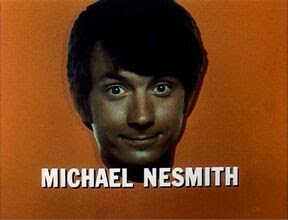 The guitar-playing singer-songwriter with the wool hat who along with Davy Jones, Peter Tork and Micky Dolenz became a TV star and 1960s pop sensation as a member of The Monkees, has died. He was 78.
The guitar-playing singer-songwriter with the wool hat who along with Davy Jones, Peter Tork and Micky Dolenz became a TV star and 1960s pop sensation as a member of The Monkees, has died. He was 78.Nesmith died Friday of natural causes, his family told Rolling Stone.
“With Infinite Love we announce that Michael Nesmith has passed away this morning in his home, surrounded by family, peacefully and of natural causes,” they said.
December 9, 2021
She's Leaving Home - A Play in Four Acts

The Beatles’ “She’s Leaving Home” is the story of a girl who runs away abruptly, leaving only “the note that she hoped would say more.” It’s based on the true story of Melanie Coe, a teenager from London whose account is told in counterpoint to the lament of her parents: “We gave her most of our lives/ Sacrificed most of our lives/ We gave her everything money could buy.” The song captures what, at the time, was headline news, the “generation gap.” The track has an abiding realism because it helps us to understand a lack of mutual understanding and the diversity of family life. Conceived by Paul McCartney, the Greek chorus of ennui was added by Lennon based on the stereotypical sayings of his Aunt Mimi. The track has inspired this “play” of interconnected songs, an exercise in realism.ACT 1 – She’s Leaving HomeINT: A London row house. Melanie creeps downstairs with a carpetbag, a plane ticket in hand, skipping over the creaky stair, then quietly locking the back door. Mother hears the door latch, picks up a letter slipped under the door, and wakes Father.Mother: Daddy, our baby’s gone.Father (with a furrowed brow): How could she treat us so thoughtlessly?Mother (tears in her eyes): We never thought of ourselves.Father (less sorrowful): We struggled hard all our lives…ACT 2 – All I WantCUT TO: The California desert. Melanie is hitchhiking across America. She wears a gauze dress in the style of the day and stands on the road near a dusty gas station with her thumb out.Melanie (thinking but out loud): I am on a lonely road and I am traveling. Looking for something. What? What can it be?A young man in a pickup truck stops. He says he can take her as far as Pearblossom. She falls asleep and when she awakens the sun has set. They stop at a country bar. He buys her a drink.Young Man (slurring his words): Do you want, do you want, do you wanna dance with me, baby? She shakes her headYoung Man: Take a chance, baby, maybe find some sweet romance. Come on.She pulls away. Next door is the Greyhound Depot. ACT 3 – 12:30EXT: The Laurel Canyon Country Market. Melanie is sitting on the step eating a sandwich. People come and go. Each smiling or saying “hello.”Melanie (thinking but out loud): At first so strange to feel so friendly, to say "Good morning," and really mean it.Melanie: Good MorningHippie Girl Just Like Her: Hi. Beautiful morning.Melanie: It ‘tis.Hippie Girl: Love your accent.Hippie Girl (walking away, singing to herself): Young girls are coming to the canyon.The Hippie Girls turns and looks at Melanie who smiles.Melanie (singing in-kind): And in the morning I can see them walking.ACT 4 – Love StreetINT: The next day. She wakes up on a strange couch. There’s another girl across the room. A young man is teaching her chords on a guitar. There is the smell of bacon.Another young man looks up from the kitchen and smiles.Young Man: Hungry?The first Young Man takes the guitar from the girl.Young Man With Guitar (singing): I see you live on Love Street./ There's this store where the creatures meet./ I wonder what they do in there?The Young Man from the kitchen comes into the living room and gives her a plate with eggs, toast, and bacon.Young Man From the Kitchen: So, what do you think?He smiles.Melanie: I guess I like it fine.She returns the smile.Melanie: So far.
December 8, 2021
A Little Bit of Help! (Parts 1 and 2)
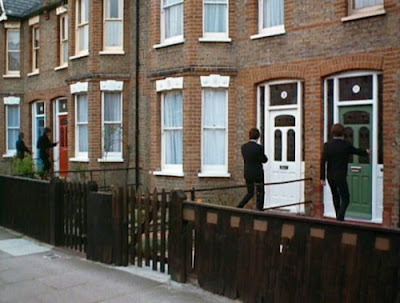 I have often mentioned my life on the fringe, from Rickie Lee and Tom Waits accusing me of stealing Rickie’s beret to my being “responsible” for Lindsay Buckingham and Stevie Nicks joining Fleetwood Mac (indeed, a stretcher, but that’s life on the fringe*). My first “job” as a journalist was as an intern at UCLA for The L.A. Weekly. A year later, I was living on my own in Hollywood, a fixture in the burgeoning new wave. The bands I covered going forward were new to the scene and included Haircut 100, Wham!, Depeche Mode, Spandau, Duran Duran – all the new new wave bands on their first gigs in America, and because there was no inherent fame associated with any of them at the time, it slipped my mind how starstruck I’d always been. Enter Paul McCartney…
I have often mentioned my life on the fringe, from Rickie Lee and Tom Waits accusing me of stealing Rickie’s beret to my being “responsible” for Lindsay Buckingham and Stevie Nicks joining Fleetwood Mac (indeed, a stretcher, but that’s life on the fringe*). My first “job” as a journalist was as an intern at UCLA for The L.A. Weekly. A year later, I was living on my own in Hollywood, a fixture in the burgeoning new wave. The bands I covered going forward were new to the scene and included Haircut 100, Wham!, Depeche Mode, Spandau, Duran Duran – all the new new wave bands on their first gigs in America, and because there was no inherent fame associated with any of them at the time, it slipped my mind how starstruck I’d always been. Enter Paul McCartney… Keep in mind that, like all of us, I’d grown up on the Beatles and during my formative years, there was never a moment when McCartney was on the radio. The McCartney canon of etched in one’s mind tracks included “Jet,” “Live and Let Die,” “My Love,” “Band on the Run,” “Uncle Albert/Admiral Halsey,” on and on and with the release of his Greatest Hits LP upon his departure from Capitol Records, McCartney was in L.A. A press session was held at the iconic Capitol Building on Vine Street and as gracious as he was, Paul was eager to answer questions about any topic – that’s when I stumbled to the podium. Of course, I said everything that everyone says about it being an honor, about it being such a special moment, and quickly I got into my diatribe extolling how Paul had been a part of my life as long as I could remember, that I was four years when my brother took me to see Help! at the Panorama theater (as if he knew where that was), how it was then that I became enamored by the Beatles. I related a story about how at every restaurant on the paper placemats I’d draw a stage with the Beatles singing “A Hard Days Night.”
It was at this point that Paul interrupted and said, “So, do you have a question, or did you just want to talk?”
But he wasn’t interrupting me and waited for me to continue. Shakily, increasingly nervous, I said, “You know there’s a scene in Help! in which each of you goes to a different door, but when you enter, you all live in the same flat?”
“I recall.” (Laughter)
“It was the first real depiction of friendship that I had in my life, and I think that many of us believe that it was real, that it was genuine, we want to believe that, and I’m just wondering, at least at that moment in time, was it real?”
I never heard Paul’s answer. Somewhere in there,
I realized that I was talking with a Beatle, and he was talking back. For one brief moment, I was a part of Paul’s world. And that’s when I passed out.

Mid-Century Modern Beatles
Post-war Britain was a solemn place. Throughout the 50s, the remnants of war were a part of the landscape. Abandoned makeshift military bases succumbing to weeds, rubble instead of jungle gyms, bombsites, and buildings with encrusted black soot. This is the setting for the bands who influenced our lives, from the Beatles to Pink Floyd to the Kinks.
That would change in the 60s with a newly-found optimism in which London would flex its might as a fashion capital and a barrage of new music would infect the world.
The term “mid-century modern” most readily conjures up images of sharp-suited businessmen, bachelor pads, and chairs from Scandinavia courtesy of movies like North-by-Northwest, or television shows like Mad-Men. In California, mid-century modern meant all-electric Medallion homes with oddly pitched roofs and a lanai. In Britain, mid-century modernism manifested as something different, coming in the form of schools, cathedrals, municipal buildings, and… The Beatles?
As imagery-laden as a watercolor by SHAG, the interconnected flats in The Beatles’ Help are a mid-century marvel. Filmed at Nos. 5, 7, 9 and 11 Ailsa Avenue, Twickenham, the Fab Four’s apartment is entered via four separate front doors (color-coded for each band member), though once we get behind these fairly ordinary doors in a fairly ordinary block we are presented with one, open-concept space, zoned by color for each member of the band: green for George (with a real grass “rug,” brown for John, blue for Ringo (with some groovy snack machines in chrome and glass and an Arne Jacobsen egg chair), and Paul’s white room, which includes an “Arco” standing lamp also seen in Tony Stark’s mansion in Iron Man.
November 30, 2021
60s 45s
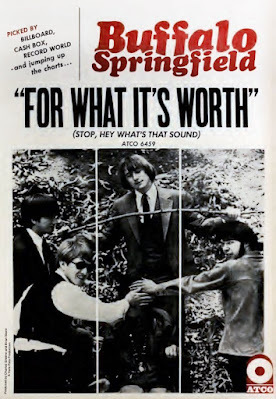 I've recently moved into a new (old) home and in the course of the move revisited my old journals that go back more than 40 (a-hem) years. In a journal from the early 90s, one of the most elaborate that I made, there is a list of the “Top 10 Songs of the 60s,” a list obviously made retrospectively. While each of the songs may not still be my faves, in the car this morning I pondered the merits of my list and the following is my attempt to justify it years later.
I've recently moved into a new (old) home and in the course of the move revisited my old journals that go back more than 40 (a-hem) years. In a journal from the early 90s, one of the most elaborate that I made, there is a list of the “Top 10 Songs of the 60s,” a list obviously made retrospectively. While each of the songs may not still be my faves, in the car this morning I pondered the merits of my list and the following is my attempt to justify it years later. 10. I first heard Dionne Warwick on the radio circa 1967. My brother had the Burt Bacharach LP, Reach Out (still one of my favorite instrumentals), and here was Dionne making the songs even better. “Walk on By” is perfect pop. Every note, every bit of phrasing is exactly as it should be, not one hair out of place; no smudged mascara here. One might even call it overproduced, but for me, I can compartmentalize every aspect of the track: the trumpet, the drum brush, Dionne’s phenomenal voice. It is the soundtrack to a 60s bachelor pad. It’s gloss, though, overshadows its melancholy.
9. Initially, “For What It’s Worth” (Buffalo Springfield) was Stephen Stills’ op-ed about the shuttering of West Hollywood’s Pandora’s Box, a teen club, the closing of which culled the riots on the Sunset Strip in 1966. The song, though, has a far more symbolic edge, representing the dissatisfaction of youth. It remains a subtle protest in the form of a monster hit.
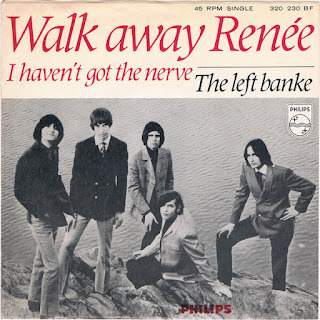 8. Unlike the radical bent of “For What It’s Worth,” “Bus Stop,” also from 1966, is one of the last of a kinder, gentler youth, Monkee-like; it’s theme, the mating rituals of modern teenagers. It’s a song about falling in love in the rain; nothing more complex than that. It’s like “The Rain, the Park and Other Things” older brother.
8. Unlike the radical bent of “For What It’s Worth,” “Bus Stop,” also from 1966, is one of the last of a kinder, gentler youth, Monkee-like; it’s theme, the mating rituals of modern teenagers. It’s a song about falling in love in the rain; nothing more complex than that. It’s like “The Rain, the Park and Other Things” older brother. 7. Everyone knows I like a good story song, sappy or not (think “Same Auld Lang Syne,” “Taxi,” or “Wildfire”), and “Ode to Billie Joe” (1967) is certainly where, for this writer, it all began. This Southern Gothic ode rivals Tennessee Williams with visuals like a Netflix crime expose, not to mention its ingenious use of interspersed dialogue. Rarely do rock lyrics rise to this level of poetic storytelling.
6. Baroque Pop was a subgenre of the Psychedelic era; a kind of pseudo-classical pop, and the height of it was The Left Banke’s “Walk Away, Renee.” The single, which would reach No. 5 on the pop charts in 1966, was a tribute to Renee Fladen, the girlfriend of Tom Finn, the Left Banke’s bassist. Oops. The saturated strings and rococo-inspired harpsichord are moving in and of themselves, but anyone can identify with the gloomy romance of rain on empty sidewalks, our narrator’s only sympathizer. Hmm. Rain seems to be a theme.
5. & 4. Okay, two songs that rival one another as the most beautiful pop songs ever written (and that from a sucker for beautiful pop songs): The Beach Boys’ “God Only Knows” and Simon and Garfunkel’s “America.” Each disguises a pervasive melancholy so prevalent as the undertone of the 60s. “God Only Knows” is what the listener wants it to be, a love song, a spiritual, a thesis of unrequited love; it is hopeful and hopeless depending on the time of day or how many drinks ones had. The song’s opening line, “I may not always love you,” is uncertain, cautious, and filled with ennui and trepidation. I may start to cry right now. It’s the sound of youth hoping against hope that love, indeed, conquers all. On a larger scale, “America” is about the lost innocence, not just of Cathy and her chum, but of America in the face of its tribulations. Unlike “God Only Knows,” “America’s” traveling companions only subconsciously understand their troubled nation. They are playful in their observations of gabardine suits and spy cameras. Not to mention that “And the moon rose over an open field” is the most beautiful sentence in all of pop music. If you’re not crying over it, you have no soul.
3. Switching gears for a bit of soul. Today I would choose “Try a Little Tenderness” or “It’s a Man’s Man’s Man’s World,” either of which vie for my top pop song of all time, but in the 90s I went through a funky-soul phase and No. 3 on my list was “Papa’s Got a Brand New Bag” (1965). I cannot even write the line without hearing the trumpets blaring of the JB Band. Almost everyone with even a passing interest in James Brown (whose name I can’t say without singing Tom Tom Club) knows that an exhausted band on tour recorded the track somewhat bedraggledly (probably not a word). Then came the studio magic. Some unknown someone got the light bulb to twist a knob marked “Speed Everything Up,” and bam, soul was funk.
2. Many will argue with this one, and I will be easily swayed, but The Byrds’ “Eight Miles High” (1966) is psychedelia’s greatest moment. And I say this from an LSD perspective – nothing rivals this song. The 12 string solo is immense and undeniable. The spacy pre-vocorder, pre-synth vocals are what psychedelics were made for – just ask Albert Hoffman (you know, cuz Timothy Leary’s dead). “Eight Miles High” came out of nowhere but its lineage is clear: the dissonant instrumental sections were unprecedented in rock, but not in jazz, where artists such as John Coltrane and Ornette Coleman shunned traditional harmonic structure in favor of free-form heroics. Out of it comes that solo on a tuned down 12-string Rickenbacker. Sublime. As the challenge is often made on FB, prove me wrong.
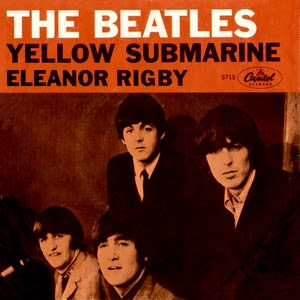 1. “Eleanor Rigby.” It’s simple. All four Beatles. George Martin at his best. An original classical (baroque) score that predates Days of Future Passed). And lyrics that put a smile on crazy ol’ Ezra Pound. It is the perfect sophisticated pop song, a song that elevated rock to something that it had never been. As an English teacher, it rivals the best in poetic verse. Here’s where I’ll go overboard (you know the No. 1 now, so you’ll probably stop reading anyway). Eleanor dies in church, buried along with her name. Even Ozymandias, despite the "lone and level sands stretch(ing) far away," has his name. In Eleanor Rigby's death we see the death of hope itself, the ultimate tragedy. (Ironically, her name lives on.) ER’s story is typical of Paul with its two functioning, unrelated characters brought into ironic proximity in the final scene, as though it were a novel by Bronte, and a precursor to "Penny Lane." One can't help but sense the influence of John upon Paul's particular choices of detailed imagery and idiosyncratic turns of phrase. The song avoids sentimentality by keeping its distance from the subject, presenting the action like a film script: "Look at him working," and uses various tense to imply shift in perspective: Eleanor Rigby "died in the church" (past tense), while in the same scene, Father MacKenzie is "wiping the dirt from his hands" (present tense). When Paul McCartney first wrote "ER" he had the music worked out before the lyrics, as he often did ("Yesterday," remember, started out as "Scrambled Eggs"). Paul often used placeholder lyrics that he'd subsequently abandon. To be specific, the original version began, "Ola Na Tungee/ Blowing his mind in the dark/ With a pipe full of clay/ No one can say." Okay, I’m done proselytizing. I could write a whole book on Eleanor and Co, but it is my No. 1 on this list and maybe on others.
1. “Eleanor Rigby.” It’s simple. All four Beatles. George Martin at his best. An original classical (baroque) score that predates Days of Future Passed). And lyrics that put a smile on crazy ol’ Ezra Pound. It is the perfect sophisticated pop song, a song that elevated rock to something that it had never been. As an English teacher, it rivals the best in poetic verse. Here’s where I’ll go overboard (you know the No. 1 now, so you’ll probably stop reading anyway). Eleanor dies in church, buried along with her name. Even Ozymandias, despite the "lone and level sands stretch(ing) far away," has his name. In Eleanor Rigby's death we see the death of hope itself, the ultimate tragedy. (Ironically, her name lives on.) ER’s story is typical of Paul with its two functioning, unrelated characters brought into ironic proximity in the final scene, as though it were a novel by Bronte, and a precursor to "Penny Lane." One can't help but sense the influence of John upon Paul's particular choices of detailed imagery and idiosyncratic turns of phrase. The song avoids sentimentality by keeping its distance from the subject, presenting the action like a film script: "Look at him working," and uses various tense to imply shift in perspective: Eleanor Rigby "died in the church" (past tense), while in the same scene, Father MacKenzie is "wiping the dirt from his hands" (present tense). When Paul McCartney first wrote "ER" he had the music worked out before the lyrics, as he often did ("Yesterday," remember, started out as "Scrambled Eggs"). Paul often used placeholder lyrics that he'd subsequently abandon. To be specific, the original version began, "Ola Na Tungee/ Blowing his mind in the dark/ With a pipe full of clay/ No one can say." Okay, I’m done proselytizing. I could write a whole book on Eleanor and Co, but it is my No. 1 on this list and maybe on others. How’d I do. Justified?
November 23, 2021
Paved Paradise
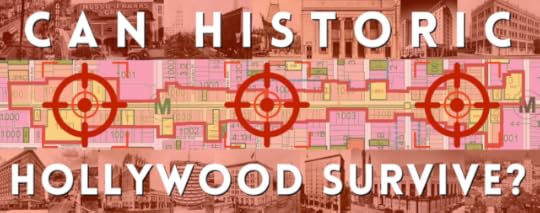 I am constantly flummoxed by the extent of misinformation on the internet and the mythologies perpetuated. But while Joni Mitchell wrote “Big Yellow Taxi” looking out over a parking lot in Hawaii, the legend that she wrote the lyrics about the demolition of the Garden of Allah on Sunset Blvd. in 1959 does, indeed, help to make a point. Los Angeles, step by step, is bulldozing its landmarks in favor of nondescript glass boxes. While the feedback I’ve received to my letter-writing campaign to the city council has reassured me that buildings like “Graumann’s” Chinese Theater (L.A. Historical Monument No. 55) and the Egyptian are “safe,” it is the people’s responsibility to consistently remind our representatives in government that we will not allow Los Angeles to lose its character, its history or its importance as a world-class destination.
I am constantly flummoxed by the extent of misinformation on the internet and the mythologies perpetuated. But while Joni Mitchell wrote “Big Yellow Taxi” looking out over a parking lot in Hawaii, the legend that she wrote the lyrics about the demolition of the Garden of Allah on Sunset Blvd. in 1959 does, indeed, help to make a point. Los Angeles, step by step, is bulldozing its landmarks in favor of nondescript glass boxes. While the feedback I’ve received to my letter-writing campaign to the city council has reassured me that buildings like “Graumann’s” Chinese Theater (L.A. Historical Monument No. 55) and the Egyptian are “safe,” it is the people’s responsibility to consistently remind our representatives in government that we will not allow Los Angeles to lose its character, its history or its importance as a world-class destination. Join AM in its due diligence. Write to your councilman.
November 22, 2021
John Garlak Rescued in the Night and Treated to a Good Steak
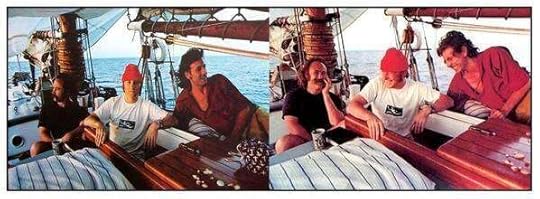
In the early 60s, The Kingston Trio was at the pinnacle of the folk/pop scene. Crossing over into top 40 often (not always) puts a bit of cash in a band’s pocket. For the Kingston Trio, a bit of cash meant 180 million dollars. No one today questions the trio’s influence on rock music, though at the time (late 50s, early 60s) there was criticism of the band’s Switzerland-like neutrality when folk music had historically taken an active liberal view. Others criticized how the Kingston Trio sanitized folk for pop radio.
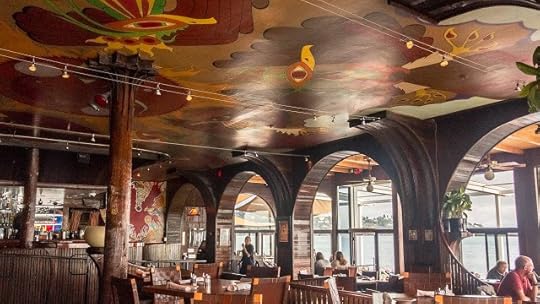 Whatever one’s take, 180 mil is quite a stash for a band whose biggest hit was “Tom Dooley” (you should have heard of it, but if not, my point is made). With their cache, the trio ventured into the restaurant business (a bit of a tax shelter), and opened The Trident in Sausalito in 1966. The walls were covered in psychedelic murals and the smell of weed permeated the dining room. While the service and fare rivaled restaurants in New York and San Francisco, the clientele was a mix of rock musicians and label execs, and movie stars.Among those who frequented The Trident was David Crosby, a fixture in Sausalito, who when there, lived on his schooner, MAYAN. DC owned the vessel for more than 45 years. On it he wasn’t a rock star, he was simply a sailor.A bit of a lengthy segue to catch your interest, which brings us to a cold and damp RJFox band on the streets of San Francisco with nowhere to go. John Garlak: “So, Joel and I went flat hunting in San Fran. We had no car, no money for a cab, it was getting dark. We were on top of the world, but we didn’t have two dimes to rub together. We’d been at it all day and it was raining this cold and steady, San Francisco, medium downpour, and we were stuck. “So what do two hippies on the verge do when they need rescue? We called DC, who the day before at Heider’s had given us his phone number on the MAYAN. The friggin’ MAYAN from the cover of CSN! We were all the way over on Potrero Hill and an hour later here comes David and his drop-dead girlfriend in a dark blue Mercedes. Over the bridge and ten miles in, I cannot believe he came to rescue us. And Joel and I are, like, soaked to the bone and we climb in back probably smelling like wet dog and DC says, ‘There’s a coat back there on the floor.’ THEE coat, the big fur David F-in’ Crosby coat, and I put it on and Joel just gives me a look. Then David lights up a J and the girl, never even knew her name, passes it back. It was like being out with, like, your older brother, but your older brother’s a rich pothead.
Whatever one’s take, 180 mil is quite a stash for a band whose biggest hit was “Tom Dooley” (you should have heard of it, but if not, my point is made). With their cache, the trio ventured into the restaurant business (a bit of a tax shelter), and opened The Trident in Sausalito in 1966. The walls were covered in psychedelic murals and the smell of weed permeated the dining room. While the service and fare rivaled restaurants in New York and San Francisco, the clientele was a mix of rock musicians and label execs, and movie stars.Among those who frequented The Trident was David Crosby, a fixture in Sausalito, who when there, lived on his schooner, MAYAN. DC owned the vessel for more than 45 years. On it he wasn’t a rock star, he was simply a sailor.A bit of a lengthy segue to catch your interest, which brings us to a cold and damp RJFox band on the streets of San Francisco with nowhere to go. John Garlak: “So, Joel and I went flat hunting in San Fran. We had no car, no money for a cab, it was getting dark. We were on top of the world, but we didn’t have two dimes to rub together. We’d been at it all day and it was raining this cold and steady, San Francisco, medium downpour, and we were stuck. “So what do two hippies on the verge do when they need rescue? We called DC, who the day before at Heider’s had given us his phone number on the MAYAN. The friggin’ MAYAN from the cover of CSN! We were all the way over on Potrero Hill and an hour later here comes David and his drop-dead girlfriend in a dark blue Mercedes. Over the bridge and ten miles in, I cannot believe he came to rescue us. And Joel and I are, like, soaked to the bone and we climb in back probably smelling like wet dog and DC says, ‘There’s a coat back there on the floor.’ THEE coat, the big fur David F-in’ Crosby coat, and I put it on and Joel just gives me a look. Then David lights up a J and the girl, never even knew her name, passes it back. It was like being out with, like, your older brother, but your older brother’s a rich pothead. 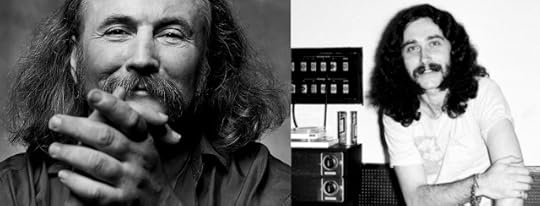
“But there’s a big ash hangin’ from it like your grandma’s cigarette, and I take a hit and the ash, cherry and all falls onto the coat. ‘Shit, shit. Shit, shit shit.’ On the outside I’m, like, handling it. On the inside, I’m panicking like nobody ever panicked before. I quietly, subtlety, and secretly brushed that ash off as fast as I could. I didn't smell fur burning, but I was too afraid to look. I crushed out the cherry on the Mercedes carpet. So, crisis diverted, we head over the Golden Gate and five minutes later we’re at The Trident, smoked another J at the friggin’ table, and then the best steak on the planet – to this day… After dinner, we head the "Mayan.” Small talk and weed and soda. Not wine or a beer, but like an RC, and I take a gulp and DC’s all grins and says it was tainted with LSD. I didn’t buy it, but who f-in’ knows, right? Maybe it was all an acid dream. We crashed in the cabin and in the morning, Crosby already up and out on deck, it’s all a picture from a jigsaw puzzle, something from a postcard, like we were on vacay, and there at the bow is a sailor in a wool seaman’s cap, an old salt who just happens to be one of the most famous rock stars in the world.
November 16, 2021
John Garlak - A Memoir - 1971
 As a journalist, I’ve always been on the fringe. No one knew my name, though most of the in-crowd walked on eggshells when they saw me up front with my steno pad. Speaking with John Garlak of RJFox this past week has reminded me of the false front I’ve put on over the years – a deadpan demeanor to hide how starstruck I always was. That said, here’s Part 2 of my talk with John in the form of a memoir:
As a journalist, I’ve always been on the fringe. No one knew my name, though most of the in-crowd walked on eggshells when they saw me up front with my steno pad. Speaking with John Garlak of RJFox this past week has reminded me of the false front I’ve put on over the years – a deadpan demeanor to hide how starstruck I always was. That said, here’s Part 2 of my talk with John in the form of a memoir:I was 21 years old. Not much younger than anyone else in the room. David Crosby was 30, but seemed worldly, like a rock sage, but h
e could have been my older brother. You know what? Despite his reputation, he was like that with everyone.
So, when DC and Stephen Barncard (who was 24) were mixing "Cowboy Movie," they couldn't decide on the fade-out. They looked our way, me and Joel [Siegel], and Stephen raised his eyebrows. Joel says, cause he was that way, and I was like his point man, “Use the one where it...”
“Where it breaks down,” I added. “Where it, you know…”
“You know, were it stops abruptly, right, with those jumbled voices with the echo.”
“Don’t fade it out. Just, bam, done.” Stephen looked at David and again raised his eyebrows. And that’s it; that’s the way it ends on the record.
 I mean, we were comfortable with them by then. Funny, later we learned that while we were waiting for Crosby that day a few weeks before when we’d just stormed into Wally Heider’s and asked for David, I guess he was watching us, trying to figure out who we were. There was like a one-way mirror on the door into the inner studio and DC wanted to make sure that we weren't, I don’t know, the cops or something. So, to be safe, he checked us out until Barncard came into the lobby and it must have seemed like Stephen, cause he’s friendly and all like that, knew us, and that’s when Crosby ventured out.
I mean, we were comfortable with them by then. Funny, later we learned that while we were waiting for Crosby that day a few weeks before when we’d just stormed into Wally Heider’s and asked for David, I guess he was watching us, trying to figure out who we were. There was like a one-way mirror on the door into the inner studio and DC wanted to make sure that we weren't, I don’t know, the cops or something. So, to be safe, he checked us out until Barncard came into the lobby and it must have seemed like Stephen, cause he’s friendly and all like that, knew us, and that’s when Crosby ventured out.
Remember, I mean, here are these two unknowns who had the guts to fly up to Frisco and just, you know, show up at the If Only I Could Remember My Name session, uninvited. Kind of funny. Twenty minutes later, DC takes us into Studio A. Studio A, oh my God, where they recorded Blue Cheer and Déjà vu. I mean, the list: American F’in Beauty! Abraxas, Cosmos Factory, Crazy Horse, Bill Withers’ debut, Neil’s debut, Stills’ debut…
Michael Shreves [Santana drummer – incredible Woodstock performance], and members of NRPS were listening to some playback. We hung and talked and smoked some weed. It’s 50 years ago and I still don’t believe I was there.
And the next day, we were listening in, you know, kind of unobtrusively, to some editing sessions for the LPs lead, “Music is Love.” It was a dreamy blur, really, of harmony overdubs and cleaning up the loose ends. It was me and Joel, Stephen, and David, and we were just, I don’t know, expected to chime in. I still wasn’t over the fact that it was a ruse that we were even there, let alone make suggestions. I mean, little did we know that 50 years later people look back on If I Could Only Remember My Name as a masterpiece of ambient folk, you know?
 Two weeks later, RJFox, the whole band, went to the studio and we’re rehearsing the bridge of a song and I’m working out this arpeggio and suddenly we look over and DC’s on the control room phone looking real solemn and sad. We could hear him through the glass, one of those one-sided conversations with someone on the other end dominating the convo, right? After DC hung up, he punched the wall by the phone in the control room, not like hard, mind you, but dejected. I don’t know how to describe it. Later we learned it was Christine Hinton’s father. He still called David all the time. It was hard on David. Such a tragedy, but maybe worse was her father’s sorrow. It was Christine who was the subject of Crosby’s “Guinevere.” The song just kept repeating in my head: “Like yours, m’lady, like yours.”
Two weeks later, RJFox, the whole band, went to the studio and we’re rehearsing the bridge of a song and I’m working out this arpeggio and suddenly we look over and DC’s on the control room phone looking real solemn and sad. We could hear him through the glass, one of those one-sided conversations with someone on the other end dominating the convo, right? After DC hung up, he punched the wall by the phone in the control room, not like hard, mind you, but dejected. I don’t know how to describe it. Later we learned it was Christine Hinton’s father. He still called David all the time. It was hard on David. Such a tragedy, but maybe worse was her father’s sorrow. It was Christine who was the subject of Crosby’s “Guinevere.” The song just kept repeating in my head: “Like yours, m’lady, like yours.”It was at Heider’s that I met Graham Nash. We’d been out of the studio the day prior. I could kick myself. Joni’d been there that day. I swear you could sense she’d been there. But Nash was there for some backup vocal overdubs. He was kind and soft-spoken. And he was there with Dallas Taylor who shook my hand and said he’d be glad to sit in with RJFox. It was before we got Spencer and Billy. His hand was rough, like a bricklayer’s.
Neil Young was there that same day. Neil just sat in the back of the control room reading the newspaper. I thought DC and Neil would be talking to each other and kidding around like buddies/friends, nope, it was pretty much silent and kind of solemn! I don’t know. They say not to meet your heroes, you know. Like The Beatles, we want them in real life to be just like they were in Help!, living in the same flat, horsin’ around.
But Neil brought an odd flavor to the studio. Maybe everyone just in awe of him. He’s big, you know and assuming. And later, even weirder, Young got himself an ice cream cone from the Good Humor Man, I guess, and he asked me if I wanted a bite. Neil Young wanted to share his ice cream cone. See, I’m telling you, it’s like something out of a dream.
I said, "Aw no, I'm ok...thanx though.” Then he came a bit closer and said to me, “Nice riffs." It was a little dinky comment/compliment, but I was thrilled to death, I mean, over the f’in’ moon. Took my breath away.
Towards the end of that evening, when people were leaving and it was just Neil, Stephen Barncard, Joel, and me, Neil gets on the piano and starts playing some "new tunes." I mean, I don’t know if anyone even heard these songs before. I don’t even remember the songs, maybe “Love in Mind,” but I'm standing by the high end of the keyboard and I’m watching NEIL YOUNG play and sing unrecorded/unreleased music, man, I'm three feet away from his head, for God’s sake. Magic.”
November 11, 2021
50 Years Ago, RJFox and the 500 Doors – an Interview with John Garlak
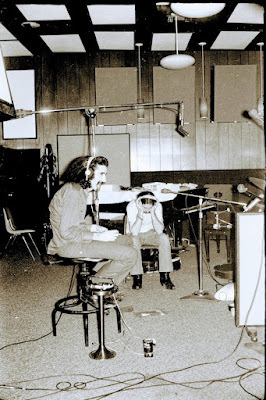 Sometimes it’s dumb luck; others, you may simply look like you belong. Such was the case on both counts with RJFox and John Garlak. You’ve never heard of them, but you should have, and, as always, better late than never. RJFox was a phenomenally talented harmony group from the Motor City, inspired by bands like CSNY and New Riders of the Purple Sage. The trio included singer/songwriters Richard Hovey (the "R"), Joel Siegel (the "J"), and Sherry Fox (the "Fox") whose harmonies and evocative lyrics would go on to spark the interest of Atlantic Records’ Ahmet Ertegun. Like the best of CSNY, the songwriting was a labyrinth of intertwining melodies and harmonies and Americana that, unlike the supergroup, would go unnoticed by all but a select group of insiders. But why? While dumb luck often allows you in the door, it equally lets the door hit you in the ass.
Sometimes it’s dumb luck; others, you may simply look like you belong. Such was the case on both counts with RJFox and John Garlak. You’ve never heard of them, but you should have, and, as always, better late than never. RJFox was a phenomenally talented harmony group from the Motor City, inspired by bands like CSNY and New Riders of the Purple Sage. The trio included singer/songwriters Richard Hovey (the "R"), Joel Siegel (the "J"), and Sherry Fox (the "Fox") whose harmonies and evocative lyrics would go on to spark the interest of Atlantic Records’ Ahmet Ertegun. Like the best of CSNY, the songwriting was a labyrinth of intertwining melodies and harmonies and Americana that, unlike the supergroup, would go unnoticed by all but a select group of insiders. But why? While dumb luck often allows you in the door, it equally lets the door hit you in the ass.Recently, I caught up with guitarist John Garlak who joined the band in 1971 before they left Detroit for the Left Coast. It was at Wally Heider’s Studio in San Francisco that “looking the part” got the newly formed quintet in the door.
John Garlak: “RJFox was an acoustic/electric guitar, three-part harmony, five-piece combo with a female sharing the lead vocals. I played acoustic and electric lead alongside our bass player, Marty Lewis. Most of us ended up living in a band house in Ferndale, Michigan. We were real good and knew that we had something cool, something special. One night we read on the Déjà Vu liner notes that CSNYs "spiritual guidance" was from David Geffen. Impetuously, we made an appointment with Geffen in L.A., flew out, set up, and played for him at his house in the hills. Yeah, try that today. He loved the girl, but didn't get our ‘band concept.’
"Bummed out and pretty sad, I picked up a copy of Rolling Stone at the hotel and took it back to the room. It was there in the "Random Notes" that we read that David Crosby was at Wally Heider's recording his solo masterpiece If I Could Only Remember My Name.” Young and fearless, the band members looked at one another. “We said ‘shit, let’s go and somehow try to get in there and play for him!
"So, Joel (J) and I flew up to San Fran, got to the front door, and told the receptionist (a long-haired stoned cat) that we were here to see DC. He got up and went into the studio. We were freaking a bit, to say the least, and then, what seemed to be 10-15 minutes, you know, forever, the door opens and there walks out David Crosby.” John says it with a grin on his face like it was yesterday. “We told him, with certainty and confidence, that we were from Detroit and had a band that was gonna blow him away!”
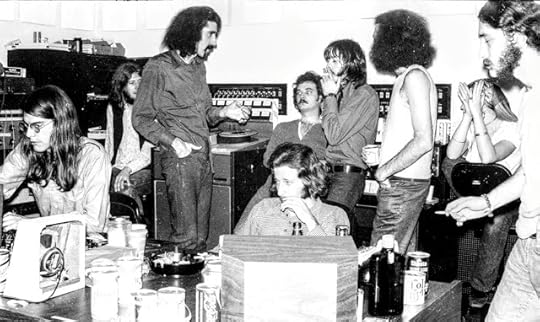
Anyone who knows David knows that he’s an asshole. At least he pretends to be. (When I was six and my mother’s boyfriend played a gig with the Byrds at The Trip on the Sunset Strip, Crosby played Ouija with me in the back room. That’s another story, but I saw right through his gruff stance, even at six years old – not to mention that I loved it that he looked like a walrus.) John continued, “DC looked at us and said, ‘Okay, come back tomorrow and play. Show me.’ Then he invited us into the inner sanction of Wally Heider’s studio. Joel and I hung out for a long while. We just didn’t want to leave.
"The next day, David’s engineer, Stephen Barncard, arrived at the studio to find the band playing with Crosby grinning from ear to ear, enthralled by the luscious harmonies." Here’s where the dumb luck comes in. Barncard thought they were friends of Crosby’s and Crosby thought they were a band Barncard was producing. Doesn’t matter how much talent you have – dumb luck rules! Out of that encounter, RJFox signed with the management team of Elliot Roberts and – wait for it – David Geffen. Better than that, the band tooled around the studio during the If Only sessions over the next few days.
Garlak: “When we played for him, he completely flipped out over us. 100% truth, I kid you not. He was rolling around the floor, laughing, and DC said to us, and I quote, he said, ‘There are 500 doors in the music business... and I'm going to open 499 of them for you’ It was some heavy fucking shit.”
With a grin still on his face, like it was his first time in a topless bar, John continued, “So, at the beginning of our recording sessions, we’d share studio time between RJ Fox and Crosby. We were in his sessions and he was in ours. Well, because he was OUR PRODUCER! He and Stephen Barncard, some heavy shit, again.
“That's how we got into the If I Could Only Remember My Name sessions. It was, to say the least, a very heady and magical period in my, in our, lives.”
Only weeks later, Ahmet Ertegun signed the band to Atlantic where they recorded their debut LP with Grateful Dead drummer, Bill Kreutzmann and Jefferson Airplane-New Riders drummer Spenser Dryden; Barncard ironically in the producer’s seat.
And then the door hit the band in the ass, ultimately leaving RJFox and its music criminally neglected for more than 20 years. While the recording was finished in three weeks, trouble was already brewing about royalties and advances with Dryden and Kreutzmann. With the album in the can, members of RJFox began hanging out with then-Grateful Dead manager John MacIntire. With good intentions, McIntire took on the task of representing the band. His negotiations too demanding, Atlantic dropped the band before the record was pressed and 499 doors closed all at once.
Nonetheless, youth and tenacity go hand in hand. Struggling against all odds, the band spent the next two years performing live and recording. A well-deserved high point came in 1972 when RJ Fox was included third on the bill at San Francisco’s Winterland, opening for the New Riders of the Purple Sage and the Grateful Dead.
Stay tuned for more from John Garlak in the days to come. In the meantime, check out RJFox on YouTube or at http://rjfox.net/rjfox/
November 8, 2021
Tomorroland Terrace and Pirate's World - 1969
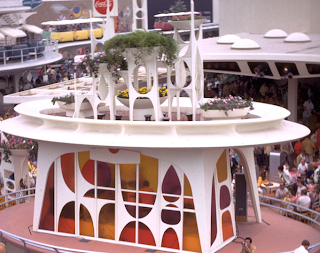 50 years ago, I was lucky enough to see the Stone Poneys at the Tomorrowland Terrace in Disneyland. Tomorrowland has always been problematic for Disney, the past of Frontierland or Main Street USA doesn't change; it's a different story trying to keep up with the future, but 1967's remodeled version of Tomorrowland was the perfect construct and vision of what the world would become. The buildings rose in a clean white symmetry and featured murals by Small World artist, Mary Blair. Across from the Carousel of Progress and America the Beautiful, the Tomorrowland Terrace would rise out of the ground with the band already playing; what had been a futuristic garden became a stage in the round. The Stone Poneys featured Linda Ronstadt and members of what would become the Eagles: Bernie Leadon, Glenn Frey, Don Henley, and Randy Meisner. Linda was like a 60s poster child in a miniskirt and bare feet and of course, the finale was Mike Nesmith's "Different Drum." It was probably the first time I was ever in love. The Happiest Place on Earth featured a mix of musical styles from Harry James and John Denver to 80s quirky post-punk band Sparks.
50 years ago, I was lucky enough to see the Stone Poneys at the Tomorrowland Terrace in Disneyland. Tomorrowland has always been problematic for Disney, the past of Frontierland or Main Street USA doesn't change; it's a different story trying to keep up with the future, but 1967's remodeled version of Tomorrowland was the perfect construct and vision of what the world would become. The buildings rose in a clean white symmetry and featured murals by Small World artist, Mary Blair. Across from the Carousel of Progress and America the Beautiful, the Tomorrowland Terrace would rise out of the ground with the band already playing; what had been a futuristic garden became a stage in the round. The Stone Poneys featured Linda Ronstadt and members of what would become the Eagles: Bernie Leadon, Glenn Frey, Don Henley, and Randy Meisner. Linda was like a 60s poster child in a miniskirt and bare feet and of course, the finale was Mike Nesmith's "Different Drum." It was probably the first time I was ever in love. The Happiest Place on Earth featured a mix of musical styles from Harry James and John Denver to 80s quirky post-punk band Sparks.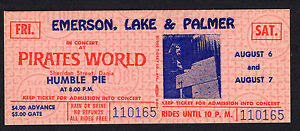 But while Disneyland could boast an eclectic selection of musical genres, it was an obscure theme park in Dania, Florida that would host some of the 60's best new bands. That theme park was Pirates World which opened in 1967 without really much of a theme, the pirate motif not fully realized. Still, there were great rides including the reconstructed Steeple Chase from Coney Island and a sky tower from the 1964 New York World’s Fair. The big attraction though was the summer concert series. Led Zeppelin played there twice; once in 1969 and once in 1971. 1970 had Iron Butterfly, Faces with Rod Stewart, the Grateful Dead, Traffic, Black Sabbath, Blood Sweat and Tears, Deep Purple with both Ritchie Blackmore and Ian Gillan and Johnny Winter would record his album Live Johnny Winter in 1970 with a release date in 1971.
But while Disneyland could boast an eclectic selection of musical genres, it was an obscure theme park in Dania, Florida that would host some of the 60's best new bands. That theme park was Pirates World which opened in 1967 without really much of a theme, the pirate motif not fully realized. Still, there were great rides including the reconstructed Steeple Chase from Coney Island and a sky tower from the 1964 New York World’s Fair. The big attraction though was the summer concert series. Led Zeppelin played there twice; once in 1969 and once in 1971. 1970 had Iron Butterfly, Faces with Rod Stewart, the Grateful Dead, Traffic, Black Sabbath, Blood Sweat and Tears, Deep Purple with both Ritchie Blackmore and Ian Gillan and Johnny Winter would record his album Live Johnny Winter in 1970 with a release date in 1971. 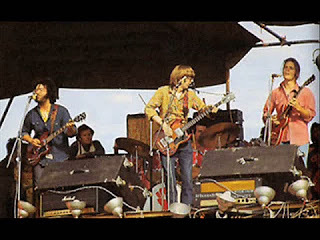 Grateful DeadJethro Tull, Grand Funk, The Steve Miller Band, the Moody Blues and Three Dog Night all played in 1971, David Bowie in 1972 along with Santana, and in 1973, Pirate's World hosted Alice Cooper and The Beach Boys. By 1973 Pirates World was experiencing hard times, with the concert venue being its only real success; it seems, up the road, a little place called Disney World had opened in 1971. Nonetheless, before the amusement park closed in 1976, the venue would feature Chicago, Steely Dan, Pink Floyd, Leon Russell, Badfinger, and Emerson, Lake and Palmer. It sounds like a list from the Hollywood Bowl or Madison Square Garden; nope, little old Pirate's World.
Grateful DeadJethro Tull, Grand Funk, The Steve Miller Band, the Moody Blues and Three Dog Night all played in 1971, David Bowie in 1972 along with Santana, and in 1973, Pirate's World hosted Alice Cooper and The Beach Boys. By 1973 Pirates World was experiencing hard times, with the concert venue being its only real success; it seems, up the road, a little place called Disney World had opened in 1971. Nonetheless, before the amusement park closed in 1976, the venue would feature Chicago, Steely Dan, Pink Floyd, Leon Russell, Badfinger, and Emerson, Lake and Palmer. It sounds like a list from the Hollywood Bowl or Madison Square Garden; nope, little old Pirate's World.


